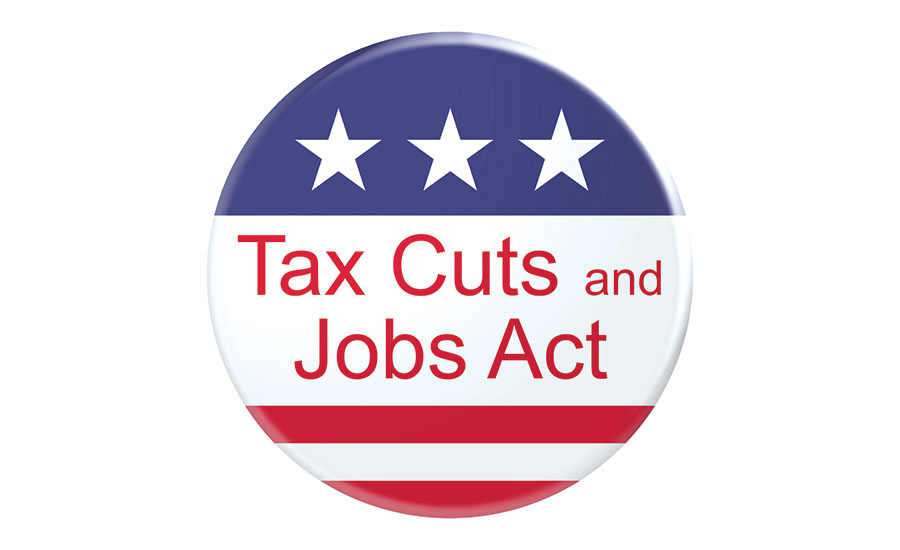The Trump administration and congressional Republicans pushed hard for a massive federal-tax overhaul in December that left virtually no segment of U.S. industry untouched, including construction.
The $1.5-trillion Tax Cuts and Jobs Act (TCJA) of 2017, which went into effect in January, amounts to “the most significant legislation of its kind in more than 30 years, since the Tax Reform Act of 1986,” says Matt Turkstra, director, congressional relations, tax fiscal affairs and accounting, for Arlington, Va.-based Associated General Contractors of America.
The headliner, of course, is the historic—and permanent—reduction of the corporate tax rate from 35% to a flat rate of 21%, a provision that will primarily affect C corporations, those typically larger enterprises that are taxed before and after the distribution of dividends.
“Some pass-throughs may want to run the numbers to determine whether it makes sense to reorganize as C corporations.”
– Liam Donovan, Tax Analyst, Associated Builders and Contractors
However, the U.S. construction industry, long burdened with one of the nation’s highest effective tax rates, lauded several TCJA provisions that also may allow small and midsize firms to increase profitability and further invest in their businesses. Nevertheless, the process of crafting TCJA “didn’t begin as well as it ended,” said AGC in December, after passage of the bill.
Of particular issue was the limited relief initially provided to general contractors and specialty contractors structured as pass-throughs—mostly small to midsize firms that include S corporations, sole proprietorships and LLCs. They distribute profits, losses, deductions and credits to shareholders to itemize on individual income tax returns.
Following numerous proposals, TCJA eventually implemented a 20% tax deduction on qualified business income pass-throughs. Those results could prove significant, given that “pass-throughs account for up to 75% of U.S. builders,” notes Liam Donovan, a tax analyst for Washington, D.C.-based Associated Builders and Contractors.
But the deduction cannot exceed the greater of 50% of the W2 wages of the business or 25% of W2 wages, in addition to 2.5% of the cost of property used in the business, Donovan says. When the dust settles, the provision reduces the effective top tax rate on business income to 29.6% for many smaller firms.
“Ideally, the deduction will allow us to improve our growth,” says Greg Ast, chief financial officer with Lakewood, Colo.-based Encore Electric Inc. The specialty contractor is an S corporation with reported earnings of $144 million in 2016. “It also will help us offset deductions repealed or reduced by TCJA, including those involving meals and entertainment,” he says.
“I would say the pass-through deduction will be of moderate benefit to our firm due to the reform’s corresponding repeal of provisions such as the domestic production-activities deduction, which amounted to 9% in certain cases,” says Tom Wolf, treasurer with Oak Creek-based Edgerton Construction Inc., an S corporation specializing in earthmoving and construction. The firm reported revenue of nearly $65 million in 2016.
Some industry organizations are taking a wait-and-see attitude about the provision. “We’ll know after first-quarter filings the impact of the deduction on income,” says Barton James, senior vice president, government relations, with the Air Conditioning Contractors of America (ACCA). Membership in the Arlington, Va.-based association comprises 4,000 companies, including HVAC contractors involved in commercial and residential construction.
For many industry firms, expiration of the pass-through deduction in 2026 is a potential concern. “AGC’s largest long-term initiative is making the pass-through deduction permanent,” Turkstra says.
“TCJA implemented several sunset provisions on individual tax rates, the pass-through deduction included, to limit the scope of the legislation to $1.5 trillion,” Donovan says. “The administration has indicated it would like to extend the pass-through deduction, but, in the meantime, the provision creates uncertainty. As a result, some pass-throughs may want to run the numbers to determine whether it makes sense to reorganize as C corporations, given the permanency of their 21% tax rate.”
More favorable reactions surround the decision by lawmakers to more than double the estate and gift-tax exclusion from $5 million to $10 million, a provision that skews toward midsize and smaller family-owned contractors and specialty contractors, says James. It’s worth noting that the exclusion is indexed for inflation occurring after 2011, with the basic exclusion amounting to $11.2 million for 2018. “One of the big issues with transitioning an estate is the time and expense of preparing for it, in order to avoid sizable tax hits,” James says. “With the larger deduction, some firms may see significant reductions in their preparation costs.” As with tax deductions for pass-throughs, the provision expires in 2026.
TCJA likewise modified the bonus depreciation, specifying a hike from 50% to 100% for first-year depreciation of certain assets, a provision of potential benefit to builders of all sizes. Nevertheless, the definition of assets such as equipment no longer excludes used items, assuming the equipment is new to the user, making equipment purchases more viable for small and midsize firms.
“That’s huge,” said Donovan. Nevertheless, TCJA has scheduled annual 20% reductions in bonus-depreciation deductions from 2023 until 2027, when the rule will be repealed. “For a period of 10 years, however, the provision promotes consistency of planning in terms of timing your tax deductions,” says Wolf.
Greater numbers of small firms also fared well with the doubling of Section 179 equipment expensing, from $500,000 to $1 million, and an increase in the phase-out threshold to $2.5 million, Turkstra says. TCJA also extended the provision to include improvements to roofing, HVAC, security and life-safety systems, including fire protection and alarms.
“It’s the biggest win in terms of simplification.”
– Matt Turkstra, Director, Congressional Relations, Tax Fiscal Affairs & Accounting, AGC of America
Additionally, greater numbers of small firms needn’t comply with the onerous percentage-of-completion method of accounting, now that it no longer applies to companies whose three-year average annual gross receipts don’t exceed $25 million. That’s compared with $10 million under the previous code. Modifications apply to firms whose contracts are estimated to be executed within a two-year period. Further, it allows firms to use the cash or completed contract methods for standard tax purposes.
“It’s the biggest win in terms of simplification,” says Turkstra. Among the reasons are look-back calculations that were incorporated into the percentage-of-completion accounting for projects lasting longer than a year, a provision requiring firms to “look back” and substitute actual costs and revenue for estimated costs after the project is completed. ABC and others have lobbied for repeal of look-back accounting due to the thousands of calculations and excessive amount of time—from 15 to 30 hours—required to review each project.
Small and midsize firms didn’t benefit from all aspects of the tax reform. In one instance, lawmakers repealed the corporate alternative minimum tax (AMT) for C corporations, but not for individuals involved in pass-throughs. The silver lining: The AMT increases the exemption amount of jointly filed taxes by married couples to $109,400 and $70,000 for individuals, rates that Donovan terms favorable relative to the previous policy.
In another instance, lawmakers limited the deductions available to individuals for sales, income and property taxes paid to state and local tax entities to $10,000, while excluding C corporations from those limitations.
Whether contractors and specialty contractors are large, medium or small, one potential benefit unites them all, says Wolf. “With the corporate tax rate fixed at 21%, we’re likely to see more activity among real estate developers, circumstances that could benefit contractors throughout the construction industry.”
“If tax reform prompts our customers to reinvest in their buildings or construct new ones, that’s the most important aspect of it,” Ast concurs.




Post a comment to this article
Report Abusive Comment